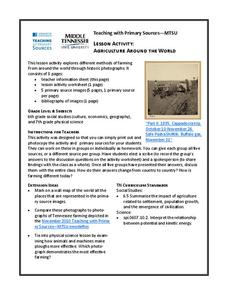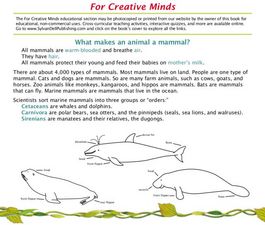Curated OER
Agriculture Around the World
Students explore various kinds of farming methods around the world. In this history lesson, students view pictures of farming methods, then compare and contrast them in a class discussion with the methods of farming that are used today.
Curated OER
Why Eat Organic?
Ninth graders explore the concept of organic eating. In this environmental stewardship lesson, 9th graders compare and contrast organic foods with conventional foods and discuss the benefits of eating organic foods.
Curated OER
Where is Agriculture?
Students explore agriculture. In this agriculture lesson, students read "Where is Agriculture?" and discuss all the things that come from agriculture. Students discuss what they need to survive and give examples of agricultural products...
Curated OER
Better Butter
Students explore the process of making butter. In this agriculture lesson, students discuss how butter is made today and how it was made in the past. Students make their own butter using baby food jars and some "elbow grease."
Curated OER
When Dinosaurs Ruled The World
Learners discover how a paleontologist digs up fossils and what tools they use. In this paleontology lesson plan, students discuss the importance of the job of a paleontologist, watch a video on the process of extracting fossils, and...
Curated OER
Pigs
Young scholars read books, learn about the letter p, and eat pigs n mud all to learn about pigs. In this pigs lesson plan, students also dance with pink ribbons and make pigs out of construction paper.
Curated OER
Stormy Weather
Fifth graders compare human and wildlife environments. In this stormy weather lesson, 5th graders imagine they are an animal or human during a storm. Students compose a story with comparisons and reasons for how an organism's habitat...
Curated OER
They Don't Just Eat Grass
Middle schoolers explore and examine different types of feed used for livestock. They discuss types of feed, the need for energy and health, and create graphs of food compared to categories. Students organize data and complete worksheets...
Curated OER
For Creative Minds: What Makes an Animal a Mammal?
Students read about categories of mammals and their features. Students then construct a marine animal, using given print outs in the lesson. Students then create adaptations for their mammal, using a web site reference for guidance.
Curated OER
Beautiful Bovine
Students compare and contrast a human body to a cow. Using a diagram, they label and identify the functions of the cow's numerous parts. In groups, they create a Venn Diagram to compare the various types of cows with one another. They...
Curated OER
Toward a Sustainable Agriculture
Young scholars examine how to use ecological analysis to animal production systems. In this sustainable agriculture lesson students examine where the nutrients flow in a system and complete several activities.
Curated OER
Hatching Chickens
Students explain the importance of carefully observing and caring for eggs and chickens in the classroom.
Curated OER
Mystery of the Malformed Frogs Lesson Plan
Students develop an understanding of how students and volunteers can make scientific observations that can aid conservation. They read the account of the Minnesota New Country School project by Ryan Fisher, Mystery of the Malformed...
Curated OER
Algal Blooms
In this algal blooms worksheet, students order the stages of a red tide. They answer two short answer questions. Students define three terms relating to algal blooms.
Curated OER
Music of the Estuary
Students explore the sounds of the estuary. In this wetlands lesson, students discuss how to simulate the sounds of nature. Students write and record a musical score featuring the sounds of the wetlands.
Curated OER
Earth Day/Nature Vocabulary
In this nature vocabulary activity, students identify nature vocabulary words by choosing the correct word for each picture. Students complete 18 problems.
Curated OER
Pyramid of Biomass
Students interpret data to demonstrate biomass and number pyramids. They use information to draw conclusions and examine an example of biological magnification.
Curated OER
What's Organic?
Young scholars define and discuss terms organic and synthetic, read article pertaining to organic agricultural practices in Oklahoma, complete worksheet, grow plants using both commercial and organic fertilizer, compare growth rates, and...
Curated OER
Non Native Species: English Ivy-Landscape Plant or Deadly Killer?
Students examine an area overrun by English Ivy. They explore how invasive species affect an ecosystem. They also study about the lack of biodiversity and how to measure it out in the field.
Curated OER
Underwater Research
Students make transect and quadrat surveys using a provided worksheet in order to understand the techniques used to study coral reefs. Each type of survey is used to identify the species, diversity, and number of corals.
Curated OER
Fur, Feathers and Fins
Students examine the stages between growing the animal and buying it at the grocery store. In food system lesson students study the role that animal products have on nutrition and study animal agriculture.
Curated OER
Era of Self-Sufficiency - Pre-1890
Students investigate the relationship between physical geography and Utah's settlement. In this Utah land activity, students view a PowerPoint about Utah land and work in groups to answer questions about the uniqueness of Utah's Mormon...
Curated OER
Do You Know Clydesdales?
For this online quiz worksheet, learners answer a set of trivia questions about Clydesdale horses. Page has a link to submit answers for review.
Curated OER
Body Language...Horse Style-Trivia Quiz
In this online quiz worksheet, students answer a set of questions about the body language of horses. Answers may be submitted for review by clicking a link at the bottom of the page.

























